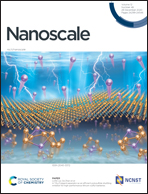Nano-assemblies of a soluble conjugated organic polymer and an inorganic semiconductor for sacrificial photocatalytic hydrogen production from water†
Abstract
Nanostructured materials have interesting optical and electronic properties that are often drastically different from those of their bulk counterparts. While bulk organic/inorganic semiconductor composites have attracted much attention in the past decade, the preparation of organic/inorganic semiconductor nanocomposites (OISNs) still remains challenging. This work presents an assembly method for the co-encapsulation of titanium dioxide dots (TDs) with a cyano-substituted soluble conjugated polymer (CSCP) into a particular nanoparticle. The as-prepared CSCP/TD semiconductor nanocomposites (CSCP/TD NCs) exhibit different particle surfaces and morphologies depending on the mass ratio of the CSCP to TDs. We then tested them as photocatalysts for sacrificial hydrogen production from water. We found that nanocomposites outperformed nanoparticles of the individual components and physical mixtures thereof. The most active CSCP/TD NC had a catalytic H2 production rate that was 4.25 times higher than that of pure polymer nanoparticles prepared under the same conditions. We ascribe this to energy transfer between the semiconductors, where direct phase contact is essential, highlighting a potential avenue for using soluble, visible light-absorbing conjugated organic polymers to build Z-schemes for overall water splitting in the future.



 Please wait while we load your content...
Please wait while we load your content...